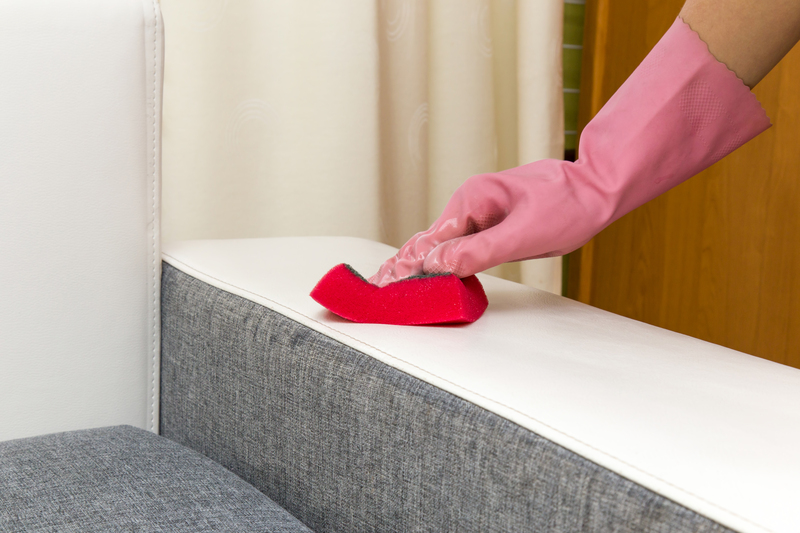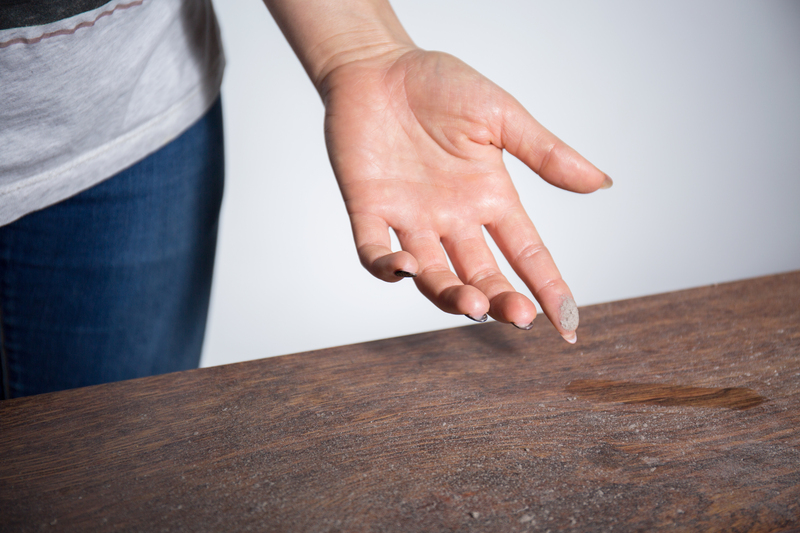Exploring effective mould cleaning solutions for window sills
Posted on 03/09/2025
Exploring Effective Mould Cleaning Solutions for Window Sills
If you've ever noticed black or greenish patches on your window sills, you know how unsightly - and potentially unhealthy - mould growth can be. Mould removal from window sills is an important task for anyone aiming to maintain a clean and healthy living space. Mould not only affects the aesthetics of your windows but can also cause respiratory issues and trigger allergies. In this comprehensive guide, we'll explore effective mould cleaning solutions for window sills using both natural and commercial products, outline the step-by-step cleaning process, discuss preventive strategies, and answer the most common questions about mould remediation.

Understanding Mould on Window Sills: Causes and Risks
Before diving into mould removal methods, it's vital to understand why mould commonly appears on window sills and the risks associated with its presence.
Why Does Mould Grow on Window Sills?
- Condensation: Windows are prone to condensation, especially during colder months or in rooms with poor ventilation. Excess moisture creates an ideal environment for mould spores to thrive.
- Leaky Windows: Improperly sealed windows allow rainwater to seep into the sill, increasing moisture levels and promoting mould growth.
- Inadequate Ventilation: Poor air circulation prevents sills from drying out, creating damp conditions that favour mould.
- Organic Material: Dust, pollen, and grime collected on sills provide a food source for mould.
Health and Property Risks
- Health Concerns: Mould exposure can cause and aggravate respiratory problems, allergies, and skin irritation. Certain types of mould, like black mould (Stachybotrys chartarum), are particularly hazardous.
- Structural Damage: Over time, mould can deteriorate wooden window sills, damage paint, and impact the surrounding structures.
Understanding these risks highlights the importance of regular window sill mould cleaning.
Top Mould Cleaning Solutions for Window Sills
There are a variety of mould cleaning solutions for window sills available, ranging from household remedies to specialised commercial products. The key is choosing the one that best matches your needs and the severity of the infestation.
Natural and DIY Mould Cleaning Methods
- White Vinegar: Vinegar is a powerful, natural mould killer. Its acetic acid content helps break down and neutralise mould spores. Spray undiluted white vinegar onto the affected area, let it sit for 1 hour, then scrub and rinse.
- Baking Soda Paste: Baking soda absorbs moisture and helps remove mould stains. Mix water and baking soda to form a paste, apply it to the window sill, scrub gently, and wipe clean.
- Lemon Juice: Lemon's acidic nature helps combat mould, leaving a fresh scent behind. Squeeze lemon juice onto the mould, allow it to sit for several minutes, then wipe away with a damp cloth.
- Hydrogen Peroxide (3% solution): Effective at killing mould and disinfecting surfaces. Spray directly onto the area, wait 10 minutes, scrub, and wipe clean. Always test on an inconspicuous spot first.
- Tea Tree Oil Solution: Mix one teaspoon of tea tree oil with one cup of water in a spray bottle. Spray the affected area, let it work for 30 minutes, then wipe with a clean cloth. This essential oil is a potent natural fungicide.
Commercial Mould Removal Products
For persistent or severe mould, specialised commercial mould cleaning sprays and solutions for sills offer stronger and faster remediation.
- Mould and Mildew Cleaners: These store-bought solutions are designed specifically to kill mould and mildew on contact. Common ingredients include sodium hypochlorite (bleach), quaternary ammonium compounds, or antimicrobial agents.
- Bleach Solutions: A diluted bleach solution (one part bleach to three parts water) is highly effective, particularly on non-porous surfaces like painted wooden or plastic window sills. Never mix bleach with other cleaners, especially ammonia.
- Specialist Eco-Friendly Cleaners: For those seeking less harsh chemicals, several eco-friendly commercial products effectively kill and remove mould without toxic fumes.
Always follow manufacturer instructions, ensure good ventilation, and use gloves when handling chemical cleaners.
Step-by-Step Guide: How to Clean Mould from Window Sills
Whether you choose a natural or chemical-based cleaning solution, the following steps outline a methodical approach for safe and effective mould removal.
1. Gather Your Supplies
- Protective gloves and a mask
- Cleaning solution (vinegar, baking soda, commercial product, etc.)
- Spray bottle
- Scrub brush or old toothbrush
- Clean cloths or sponges
- Bucket of clean, warm water
2. Protect Yourself and Surroundings
- Wear gloves and a mask to avoid direct contact with mould spores.
- Open windows for ventilation and to help the area dry quickly after cleaning.
- Place a towel or drop cloth below the window sill to catch drips and debris.
3. Remove Loose Mould
- Use a dry paper towel or brush to gently remove loose mould spores from the sill's surface. Dispose of these materials in a sealed plastic bag immediately.
4. Apply Your Chosen Cleaning Solution
- Spray or apply your chosen mould cleaning solution for window sills liberally to cover all visible mould and affected areas.
- Let the solution sit for at least 10 to 60 minutes, depending on the product and severity of the growth. This gives the cleaner time to kill mould at its roots.
5. Scrub the Area Thoroughly
- Using a scrubbing brush or old toothbrush, work the cleaner into the mouldy areas, paying special attention to corners and crevices where mould is likely to hide.
6. Wipe Clean and Rinse
- Use a clean, damp cloth to wipe away dead mould and excess cleaning solution. Rinse with clean water and dry with a separate cloth.
7. Dry the Window Sill Completely
- Mop up any remaining moisture and leave the window open, or use a fan to ensure the area dries thoroughly. This helps prevent new mould growth.
Prevention: Keeping Window Sills Mould-Free
Once you've eliminated mould, it's crucial to take steps to stop it from returning. Here are the most effective tips to prevent mould on window sills:
- Improve Ventilation: Regularly open windows or use fans to increase airflow in rooms prone to condensation, such as bathrooms and kitchens.
- Use a Dehumidifier: Maintaining indoor humidity below 60% makes it harder for mould to flourish.
- Fix Leaks Promptly: Repair leaking windows and ensure sills are properly sealed to prevent water ingress.
- Wipe Sills Regularly: Clean and dry window sills at least once a week, especially during humid seasons.
- Trim Vegetation: Keep outdoor plants away from windows to reduce external moisture and organic debris accumulation.
- Insulate Windows: Upgrading to double glazing or adding window insulation film can reduce condensation on sills.
Addressing Persistent or Large-Scale Mould Infestations
While most homeowners can manage small-scale window sill mould removal themselves, certain situations call for professional help:
- Mould covers a large area: If mould covers more than one square meter, the infestation may be extensive behind walls or woodwork.
- Recurring Mould Growth: Continuous regrowth may indicate ongoing moisture issues or hidden leaks.
- Health Vulnerabilities: Those with respiratory conditions, allergies, or weakened immune systems should minimise exposure and consider professional remediation.
- Black Mould (Stachybotrys chartarum): This toxic species requires expert removal due to its health risks.

Frequently Asked Questions About Window Sill Mould Cleaning
What is the best solution for cleaning mould off window sills?
White vinegar is one of the most popular and effective non-toxic solutions for mould removal on window sills. For heavier infestations, a commercial mould remover or diluted bleach solution may be necessary.
Can I use bleach to clean window sill mould?
Yes, bleach is effective for cleaning mould from non-porous surfaces, but it may not penetrate porous wood deeply enough to kill all spores. Always dilute bleach with water (1:3 ratio), ensure good ventilation, and NEVER mix with other products.
Is it safe to clean mould myself?
Most small-scale window sill mould cleaning can be safely performed with gloves, mask, and proper ventilation. However, large, persistent, or toxic mould problems warrant professional involvement.
How often should I clean my window sills to prevent mould?
Aim for a quick wipe-down at least once a week, and a deep clean every few months, especially during high-humidity seasons.
Why does mould keep returning to my window sills?
Persistent mould is often caused by unresolved moisture issues. Improving ventilation, sealing windows, and using a dehumidifier can help break the cycle.
Conclusion: A Healthier Home Starts with Clean Sills
Mould on window sills doesn't just spoil the look of your home - it could also be a sign of deeper moisture problems and a trigger for health concerns. By using the right mould cleaning solutions for window sills, following best-practice cleaning methods, and taking steps to prevent future outbreaks, you can keep your windows spotless and your home environment safe.
Don't let mould take root: make window sill mould removal a regular part of your household cleaning regime, and you'll enjoy a fresher, healthier living space all year round.




